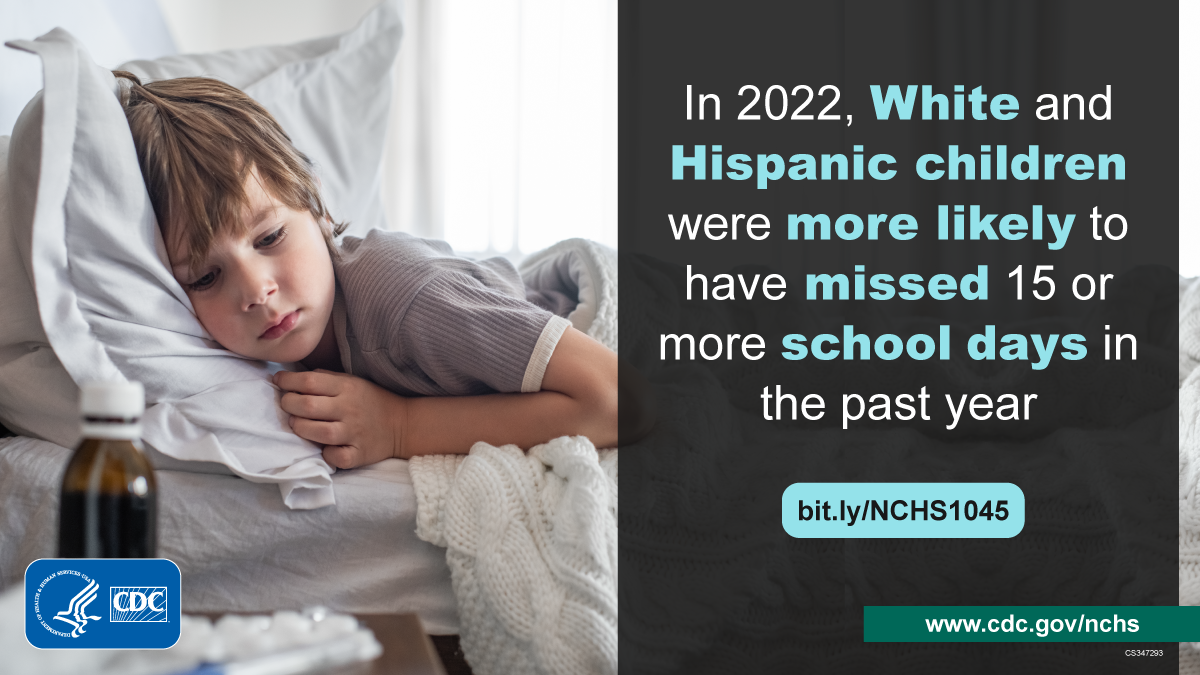Q & A from the Report Author of Chronic School Absenteeism
Posted on by Questions for Lindsey Black, Statistician and Lead Author of “Chronic School Absenteeism for Health-related Reasons Among Children Ages 5‒17 Years: United States, 2022”
Questions for Lindsey Black, Statistician and Lead Author of “Chronic School Absenteeism for Health-related Reasons Among Children Ages 5‒17 Years: United States, 2022”
Q: What would you say was the most significant finding in this report?
LB: There are few national data sources available to examine the prevalence of school absenteeism due to health-related reasons. The ability to examine this topic using the most recent 2022 National Health Interview Survey is of interest in of itself. We found that 5.8% of school-aged children, that is –children aged 5-17 years– experienced chronic school absenteeism, that is –missing 15 or more school days due to injury, illness, or disability–. The prevalence of chronic school absenteeism was not statistically different across the age groups, meaning that we did not find an association between age group and experiences chronic school absenteeism for health-related reasons.
Q: How many days does a child have to miss in school for their absences to be labeled as chronic absenteeism?
LB: Chronic school absenteeism in this report is defined as missing 15 or more days. We used this definition as it is in line with the U.S. Department of Education’s definition of chronic school absenteeism. Of note, our measure is specific to missing school because of a child’s illness, injury, or disability. Data are based on the parent-report.
Q: Did the report find that absenteeism varied by race, socioeconomic status, or sex? Which group was more likely to experience chronic absenteeism?
LB: We did not find differences in chronic school absenteeism by sex. However, there were differences by race and socioeconomic status which was measured using family income. White and Hispanic children were more likely to have experienced chronic school absenteeism compared with Black and Asian children. Children living in households with family incomes of less than 200% FPL had a higher percentage of chronic school absenteeism compared with children living in households with higher family incomes.
Q: What is the biggest family risk factor that encourages a child having chronic absenteeism?
LB: Much of the literature on this topic spans the past decade and has a focus on individual risk factors such as having a chronic health condition, developmental disability, poor mental and behavioral health (1-4). We wanted to use the most recent 2022 NHIS data to examine population subgroup differences of children that experience chronic school absenteeism for health-related reasons. In our report, we examined one family-level indicator, family income, and saw a clear gradient in that as family income increased, the percentage of children with chronic school absenteeism for health-related reasons decreased. It is important to continue to monitor the prevalence of chronic school absenteeism for health-related reasons as data from the National Center for Education Statistics (NCES) School Pulse Panel (SPP), a survey of school leaders, has found that student chronic absenteeism has increased generally since 2020. NHIS is a rich data source that could be used to further understand individual, family, and neighborhood-level risk factors of chronic school absenteeism for health-related reasons.
- Taras H. Potts-Datema W. Chronic health conditions and student performance at school. Journal of School Health 75(7):255-266. 2005.
- Black LI, Zablotsky B. Chronic school absenteeism among children with selected developmental disabilities: National Health Interview Survey, 2014–2016. National Health Statistics Reports; no 118. Hyattsville, MD: National Center for Health Statistics. 2018.
- Willits KA, Troutman-Jordan ML, Nies MA, Racine EF, Platonova E, Harris HL. Presence of medical home and school attendance: an analysis of the 2005-2006 National Survey of Children With Special Healthcare Needs. J Sch Health 83: 93-98. 2013.
- Totsika V, Kouroupa A, Timmerman A, et. al. School attendance problems among children with neurodevelopmental conditions one year following the start of the COVID-19 pandemic. Journal of Autism and Developmental Disorders Online ahead of print. 2023.
Q: Does this report update a past report or is it a standalone new report? Will this kind of report continue to be conducted in the future?
LB: This is a new, standalone report. However, our Division supports the Interactive Summary Health Statistics for Children, which is updated annually with NHIS data for a measure of school absenteeism that is categorized as missing 11 or more days. It currently has data from 2019 through 2022. We anticipate updating this tool in Fall with the 2023 NHIS data.
Posted on by

